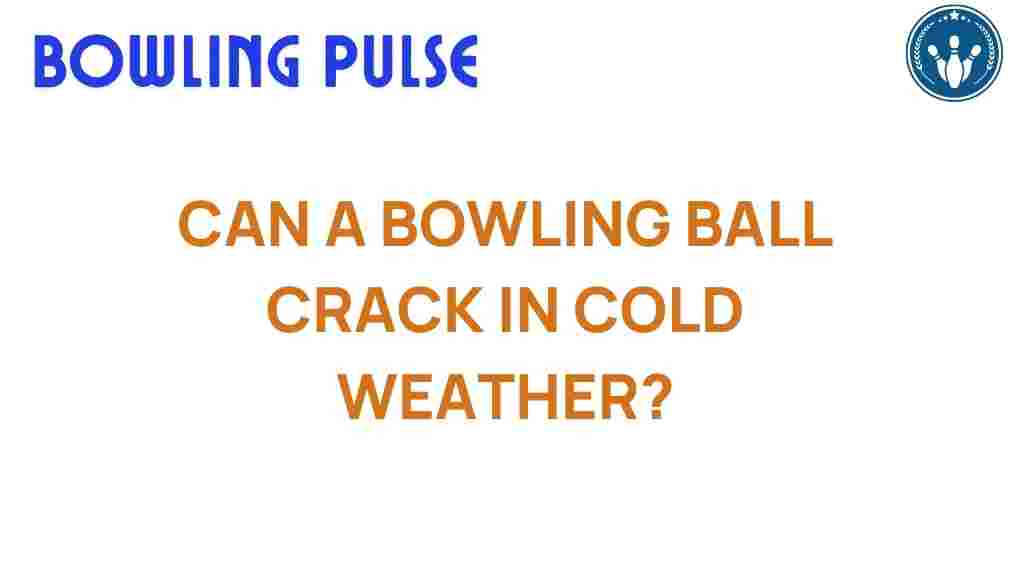The Chilling Truth: Can a Bowling Ball Crack in Cold Weather?
As winter approaches, many bowling enthusiasts eagerly anticipate the chance to hit the lanes and enjoy their favorite sport. However, with the drop in temperature, a pressing question arises: can a bowling ball crack in cold weather? Understanding the effects of temperature on sports equipment, particularly bowling balls, is crucial for maintaining their durability and ensuring optimal performance. In this article, we will explore the relationship between cold weather and bowling ball durability, provide essential maintenance tips, and offer advice for winter care.
The Science Behind Bowling Ball Materials
Bowling balls are primarily made from three types of materials: polyester, urethane, and reactive resin. Each material has its own properties, which can influence its performance and durability, especially in varying temperatures.
- Polyester: Known for its durability and affordability, polyester balls are the most common entry-level choice. They are less prone to cracking but may not perform as well in cold temperatures.
- Urethane: Offering a balance between performance and durability, urethane balls are more sensitive to temperature changes. In cold weather, they can become harder, potentially leading to cracking if mishandled.
- Reactive Resin: These high-performance balls provide excellent grip and hook potential. However, the flexible nature of reactive resin can also make them susceptible to damage in extreme cold.
How Cold Weather Affects Bowling Balls
Cold weather can have significant effects on bowling balls, leading to potential issues such as cracking or breakage. Here are some crucial points to consider:
- Temperature Effects: Most bowling balls are designed to perform best at room temperature. When exposed to cold conditions, the materials can harden, making them brittle and more susceptible to damage.
- Rapid Temperature Changes: Bringing a cold bowling ball into a warm environment can lead to condensation, which can weaken the ball’s structure over time.
- Physical Stress: Using a cold bowling ball can increase the risk of cracks during play due to the added stress from impacts against the pins and lanes.
Signs Your Bowling Ball Might Be at Risk of Cracking
Recognizing the signs of potential damage to your bowling ball can prevent costly repairs and keep your game on track. Look for the following indicators:
- Visible Cracks: Any noticeable cracks on the surface of the ball can compromise its integrity and should be addressed immediately.
- Loss of Performance: If your ball seems to be hooking less or not performing as expected, it could be a sign of physical damage.
- Surface Imperfections: Dents, scratches, or other surface irregularities can indicate a problem, especially if they appear suddenly.
Bowling Ball Maintenance in Cold Weather
To ensure your bowling ball remains in top condition during the winter months, follow these maintenance tips:
- Store Properly: Keep your bowling ball in a climate-controlled environment when not in use. Avoid leaving it in your car or in unheated spaces.
- Gradual Temperature Transition: If you need to move your ball from a cold to a warm environment, allow it to acclimate slowly to prevent condensation and thermal shock.
- Regular Cleaning: Clean your ball regularly to remove oil and dirt that can accumulate and affect performance. Use a specialized bowling ball cleaner for the best results.
- Inspect Frequently: Regularly inspect your bowling ball for any signs of damage or wear, especially after extreme temperature changes.
Winter Care Tips for Your Bowling Gear
In addition to caring for your bowling ball, it’s essential to also maintain your other bowling equipment. Here are some winter care tips:
- Bowling Shoes: Keep your bowling shoes dry and store them in a moisture-free environment. Consider using shoe bags to protect them from cold weather.
- Towels and Accessories: Ensure that your towels are clean and dry. Wet or damp towels can promote mold and mildew, affecting your gear.
- Bag Maintenance: Store your bowling bag in a warm area to protect your equipment and prevent any potential damage from cold conditions.
Bowling Tips for Cold Weather
To enhance your performance while bowling in cold weather, consider the following tips:
- Warm Up: Always warm up before bowling. Stretching and light exercises can help your muscles adjust to the colder conditions.
- Adjust Your Grip: Be mindful of how cold weather can affect your grip on the ball. You may need to adjust your hold to maintain control.
- Choose the Right Ball: If you have multiple bowling balls, select one that is less susceptible to cold weather effects, such as a polyester ball for casual play.
Troubleshooting Cracks and Breakages
If you discover cracks or damage to your bowling ball, it’s essential to address the issue promptly. Here are some steps you can take:
- Assess the Damage: Determine the severity of the crack. If it’s minor, you may be able to continue using the ball, but for significant damage, consider replacement.
- Consult a Professional: If you’re unsure about the condition of your ball, consult a bowling pro shop or equipment specialist for an evaluation.
- Consider Repair Options: Some minor cracks may be repairable through professional services. Evaluate whether the cost of repair is worth it compared to purchasing a new ball.
Conclusion
In conclusion, while bowling balls can crack in cold weather, proper maintenance and care can significantly reduce the risk of damage. By understanding the effects of temperature on your sports equipment and following the recommended winter care tips, you can ensure that your bowling ball remains durable and performs optimally throughout the season. Remember to store your equipment properly, inspect it regularly, and adjust your bowling techniques to adapt to cold conditions.
For more information on bowling ball maintenance and tips, visit this helpful resource. Stay warm, and keep striking!
Additionally, if you’re looking for high-quality bowling balls that withstand cold weather, check out this external link for the best selections.
This article is in the category Equipment and created by BowlingPulse Team
